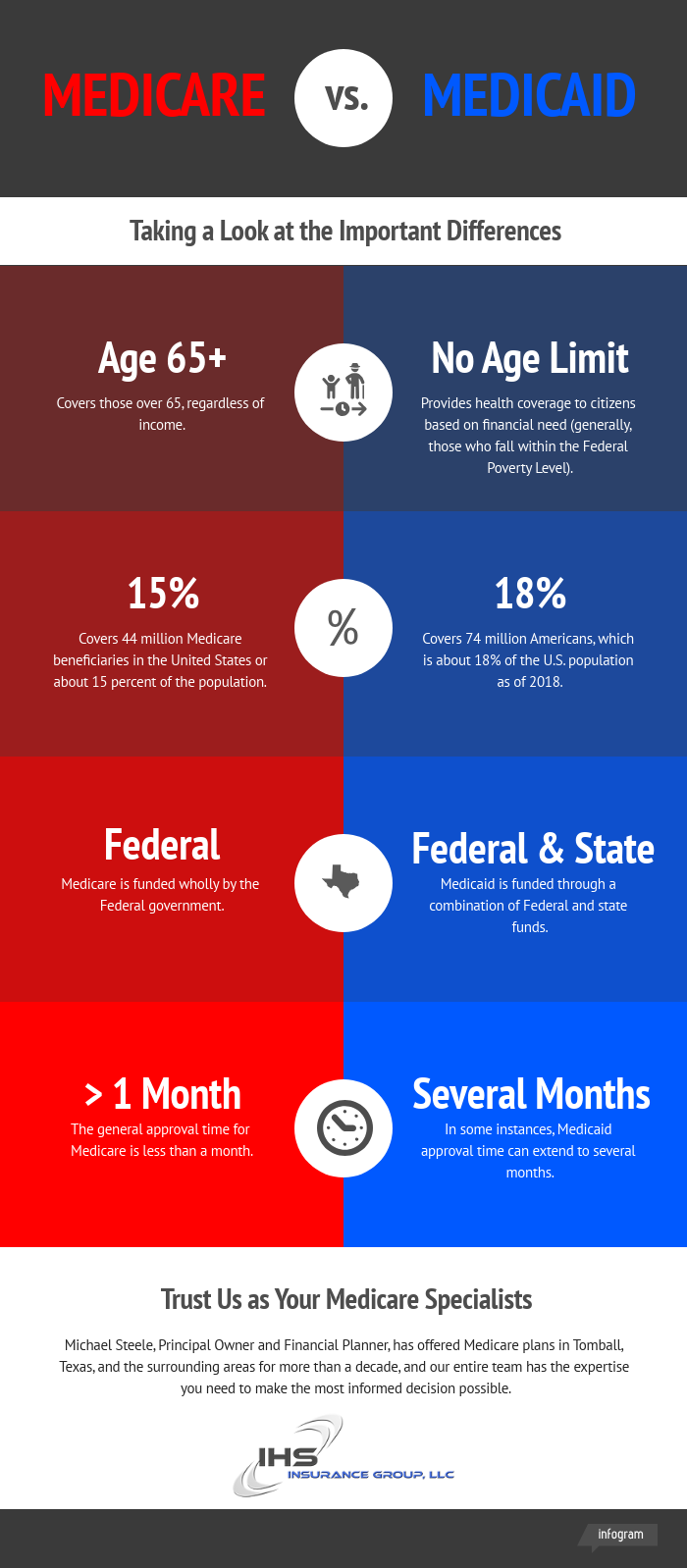
The Differences Between Medicare and Medicaid
Medicare and Medicaid are both government programs that provide health coverage. And although they might sound alike, the similarities end there.
In this article, IHS Insurance Group’s professionals will help you quickly understand the key differences between Medicare and Medicaid and what they could mean for you in the real world.
Medicare Basics: Definition, Eligibility, & Coverage
Medicare is a federally funded program that primarily provides health coverage to senior citizens, or those over 65, regardless of income. Individuals under 65 with specific disabilities, such as End-Stage Renal Disease, may also qualify.
Related: How Does Medicare Work?
According to the AARP, there are currently 44 million Medicare beneficiaries in the United States or about 15 percent of the population. This number is estimated to skyrocket to 79 million enrollees by 2030.
You automatically qualify for Medicare once you turn 65, and you can enroll starting three months before the month of your birthday, which ends three months after your birth month. If you already receive social security benefits at that time, you’re automatically enrolled.
From there, it usually takes less than a month to receive your Medicare card.
Related: How You Can Easily Enroll in Medicare
From a coverage perspective, the Medicare ‘ecosystem’ consists of four essential parts:
- Part A –Includes inpatient hospital care, skilled nursing facility and custodial care, hospice and palliative care, and limited home health care and preventative services.
- Part B – Supplement plans sold through third-party companies that add coverage not provided by Part A, including medically necessary services and preventative services.
- Part C – Policies sold by independent insurance carriers that include coverage for all federally mandated Part A and Part B services. Part C plans, also known as Medicare Advantage plans or Medicare Health plans, can also include extras for vision, hearing, dental, health and wellness programs and services, as well as prescription medications.
- Part D – Plans that cover some, if not all, of your prescription costs. You can choose between Part D Prescription Plans directly from the Centers for Medicare and Medicaid Services (CMS), or from third-party insurance companies (HMOs or PPOs) that combine your Part A, Part B, and Part D coverage together under a single policy.
How does all of this compare to Medicaid? Let’s continue our discussion in the next section.
Medicaid Basics: Definition, Eligibility, & Coverage
Compared to Medicare, which is primarily age-based, Medicaid eligibility is mostly centered around providing health coverage to citizens based on financial need (generally, those who fall within the Federal Poverty Level). You can be dually eligible for Medicaid and Medicare, and simultaneously receive coverage—and lower costs—from each program.
According to the Medicaid.gov website, Medicaid is the single largest source of health coverage in the United States, which covered about 18% of the population as of 2018.
Like Medicare, Medicaid is funded by the federal government, but also on the state level via taxes. As a result, Medicaid can work differently in each state, and some may charge out-of-pocket fees for services.
For example, Medicaid.gov explains, “States have additional options for coverage and may choose to cover other groups, such as individuals receiving home and community-based services and children in foster care who are not otherwise eligible.”
Finally, compared to Medicare’s relatively short approval process, Investopedia emphasizes:
“Application rules vary by state, but be aware that the process may take weeks or even months. You may also be required to take a medical screening and may be asked to provide extensive documentation of past and present financial transactions.”
For additional details, you can check out the financial and non-financial eligibility criteria outlined on the Eligibility page of the Medicaid.gov website.
Next, we’ll bring all of this information together.
Medicare vs. Medicaid: The Coverage Chart
We’ve covered a lot of information in a relatively short amount of space in this article. To help visually summarize everything we’ve discussed, here’s a brief table comparing the significant differences between Medicare and Medicaid:
| Medicare vs. Medicaid | ||
| Medicare | Medicaid | |
| Coverage Base | 44 million Americans | 74 million Americans |
| Funding Source(s) | Federal | Federal & State |
| Age-Based? | Y | N |
| Income-Based? | N | Y |
| Disability-Based? | Y | N |
| Physical Screening Required? | Rarely, unless applying before the age of 65 based on a disability | Potentially |
| Additional Eligibility Requirements? | No | Possibly, depending on the state |
| General Approval Time | Less than 1 month | Varies, but can take months in some instances |
Who Can You Turn to As a Medicare Specialist?
If you qualify and are wondering whether you should choose Original Medicare or an alternative Plan C from a third-party company, the professional staff at IHS Insurance Group is here to help.
Michael Steele, Principal Owner and Financial Planner, has offered Medicare plans in Tomball, Texas, and the surrounding areas for more than a decade, and our entire team has the expertise you need to make the most informed decision possible.
Need a FREE Quote or have questions regarding Medicare Coverage? We have three convenient ways to reach us:
- If you prefer to talk to a licensed agent directly, please call (866) 480 5063.
- If you prefer to fill out a quick form and have an agent get back with you at your convenience, use the GET A FREE QUOTE.
- Lastly, for those that want an immediate quote, please click HERE.
Also, check out our Medicare FAQ’s here.


